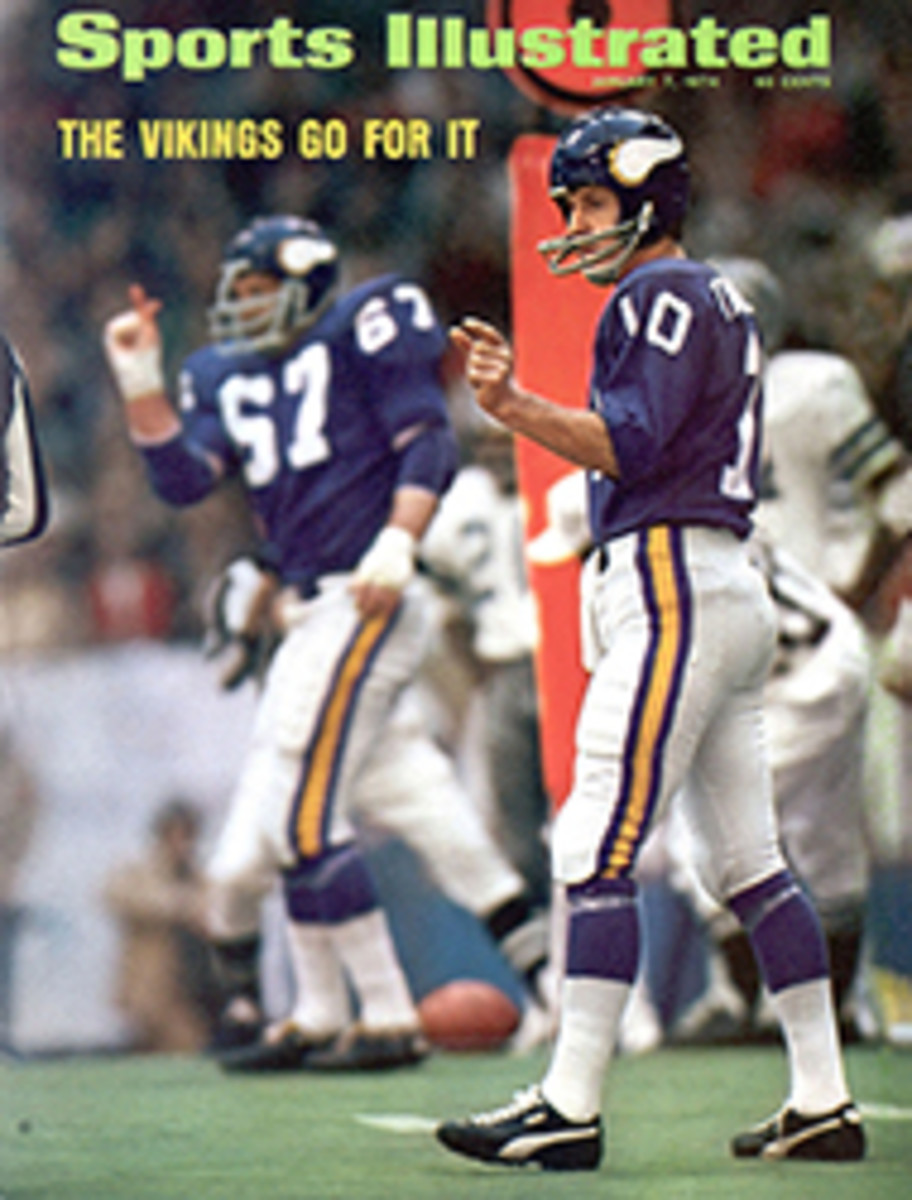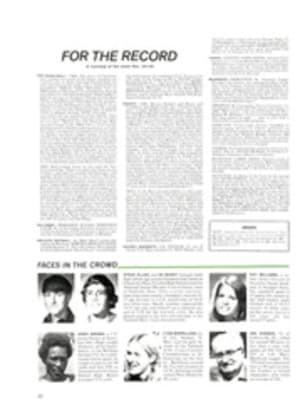
MINNESOTA GAVE OUT SOME MISDIRECTIONS
On the surface it looked as if Minnesota simply overpowered Dallas last Sunday in winning the National Football Conference title 27-10. But in a sense this impression was as false as the Tartan Turf that carpets Dallas' plush, sun-roofed stadium.
The game was won by subtle changes in attack by the Vikings and lost by the inability of the Cowboy defense to recognize them and adjust. Things were so bad that the Dallas coaches on the sideline and their confreres in the press box spent the first half fruitlessly arguing about what was happening on the field. Alas, in the second half, when the defense got with it and began to shut off the Vikings and force turnovers, the hospitable Cowboy offense kept giving the ball right back to Minnesota.
"We knew exactly what we had to do," said Viking Guard Ed White. "The Cowboys play a reading defense and protect Lee Roy Jordan, their middle linebacker, so that he can make the stop after the line has read the play. We worked out ways to get to Jordan and we had him moving the wrong way by misdirection."
Throughout the season, when Minnesota's left guard pulled, the running back on the left side of the set got the ball; on Sunday, Quarterback Fran Tarkenton (see cover), who called a brilliant, daring game, handed off to the other back, who carried in the opposite direction from which the guard pulled.
"I took myself out of the play during the first half," Jordan said ruefully. "They were pulling people the wrong way. The coaches in the press box and on the sideline couldn't agree on who was pulling where. Then by the half we were behind 17-0."
It was pointed out that Dallas was only behind 10-0 at halftime. "It felt like 17-0," Jordan muttered. "Anyway, I got too conservative. I should have audibled and changed up the defense. In the second half, when we were getting the ball in close on turnovers, the offense winds up back on the 50-yard line."
The deficiency in the Cowboy defense was most evident in the first half, in which the Cowboy offense had the ball only three times. The Vikings mounted two long drives during which they established a pattern Dallas had difficulty picking up. On first down, more often than not, Tarkenton passed. On second and long he handed off to Chuck Foreman or Oscar Reed, who ran surprisingly well. All told, the Vikings rushed for 203 yards, the Cowboys for only 90.
"I didn't realize that Fran was passing so much on first down," Minnesota Coach Bud Grant said. "It wasn't part of our game plan."
"We passed on first down because the Cowboys are almost always in their flex defense then," said White. "With two linemen playing back off the line of scrimmage, they can't get a good pass rush. Then, when they went into a pass defense on second down, we ran."
The run was successful because the Vikings had another tactic to nullify Jordan. "We had nearly everyone on the line taking him at one time or another," said Center Mick Tingelhoff, who normally would have had most of the responsibility for blocking Jordan. "Sometimes one of the guards would block him, then a tackle and even the tight end came down after him. We knew we had to take him out of the game, and I guess we did."
Minnesota's first-half drives resulted in a field goal and a touchdown and each of the marches was kept alive by uncharacteristic plays. The first came on fourth and one on the Dallas 17. Normally, a coach as conservative as Grant would have settled for a field goal. He elected to go for the first down. "Bud isn't a big gambler, but we all felt we could make it, and I guess he had the same feeling," said Carroll Dale, the wide receiver who has played in more big games than most Vikings, since he was a member of the Green Bay Packers in the Lombardi era. "On that play, most of the time I would have left the field for an extra tight end, but I didn't. I knew we would go for it because all of us knew, one way or another, we would make it."
Indeed, Reed slashed for the first down but a penalty forced the Vikings to settle for Fred Cox' 44-yard field goal, his longest of the year.
In the second quarter Minnesota duplicated its first drive, except that Tarkenton capped it with a touchdown. He opened the march with a first-down pass from his 14 to Tight End Stu Voigt, who curled over the middle for 16 yards. Tarkenton's first-down passes failed after that, but he compensated by calling crafty running plays on second and long. And once again, with a fourth and one on the Dallas 28, Grant gambled, Foreman scratching out the first down.
Then Tarkenton put his head down and scrambled for 11 yards. Eventually, behind a thumping block by Tackle Ron Yary on Corner Linebacker Dave Edwards, Foreman swept right for five yards and the touchdown. Jordan, as usual, had been misdirected and haplessly trailed the play.
The second half was as undisciplined and sloppy as the first half had been clean and careful. If it proved anything, it was that the Vikings can win as readily in a loosely played game as they can in a tight and controlled one. They gave away the ball four times in their own territory; four times their defense regained the ball and on the four turnovers Dallas wound up minus 10 points.
The Cowboys got back in the game on a 63-yard punt return by Golden Richards in which Minnesota, kicking from its end zone, had to keep everyone at home to block, giving Richards running room. That brought the score to 10-7 and momentarily turned the game toward Dallas, but Tarkenton turned it right back, helped by the dazed condition of Cornell Green, the Dallas strong safety. Green had taken a shot to the head in the third quarter, leaving him fuzzy, but no one knew it until Tarkenton had hit fleet John Gilliam on a 54-yard touchdown pass 1:03 after Richards' revivifying punt return.
Again it was a first-down pass against the flex defense designed to stop the run, and Tarkenton had time. Gilliam ran a simple pattern—full speed down the field, a cut to the inside—and the ball, thrown as far as Tarkenton can throw ("a rainbow pattern," Grant called it) was hanging for him, just beyond the reach of Green and Mel Renfro, who had come over to help.
"The defensive backs had a meeting on the sideline after that play," Renfro said later. "I asked Cornell what defense we were in and he said he didn't know. He was dazed. He saw his man open and chased him, but it was too late. Actually, he distracted me when he got close."
Even so, Dallas was presented with a series of opportunities to win the game. First, the Cowboys were given the ball on a fumble by Foreman, which they recovered on the Minnesota 37. Roger Staubach gave it back by throwing a pass that bounced off Tight End Billy Joe DuPree and wound up in the hands of Middle Linebacker Jeff Siemon. Next, Tarkenton forced a sideline pass to Gilliam, and Cornerback Charlie Waters stepped in front of him for an easy interception, carrying the ball to the Minnesota 24.
Staubach fumbled a few plays later, Minnesota recovering on its 45. Foreman fumbled the ball back, Dallas recovering on the Minnesota 47. Staubach threw a bad pass to Bob Hayes, which was picked off by Cornerback Bobby Bryant and returned 63 yards for the score that wrapped up the game for the Vikings.
Staubach, who had a total of four interceptions, had a bad day, but you can't pin the loss on him. If anyone in the Dallas organization is to blame, it is Coach Tom Landry, who apparently underestimated the ingenuity of the Minnesota coaching staff. Jethro Pugh, the top Cowboy tackle with Bob Lilly out of the game, said it indirectly: "They had plays we had not seen before. They were good plays against the defense we were running."
Strangely, most of the Cowboy defenders did not recognize what Tarkenton was doing to them—notably, 11 of his 21 passes coming on first down. "I didn't know that," Jordan said. "But what the bleep, it didn't make that much difference. They were gaining six yards on first down and they aren't supposed to do that. Then, when we stopped them, the offense didn't do anything."
Staubach felt the game turned on the interceptions by Siemon and Bryant. "I thought I had looked Bryant off," he said. "It was a question of timing."
In a larger sense, the timing was off for the Cowboys all afternoon. They missed not only Lilly but also Calvin Hill, their 1,000-yard-plus running back and leading pass receiver, who had a dislocated elbow. Hill's replacement, Robert Newhouse, gained but 50 yards, and the usually reliable Walt Garrison got only nine on five carries and fumbled away the ball on the Minnesota two-yard line. But what the Cowboys missed most of all was an adequate method of responding to the changes the Vikings made in their offense.
They made no changes in their defense; the Cowboys did not come up with anything different to confuse them. Minnesota's Gary Larsen, who had a fine game at defensive tackle, said, "They did the things they have done all year. They give you a lot of movement in the backfield and they want you to look at it, but we ignore all that. We just take our position and maintain it. We don't care what they do before the play starts. Once it's under way they're running from one of two sets, like everyone else. We just cut them off after they got through fiddling around." While Dallas burned.
PHOTO
Suckered away from the flow of the play, Jordan vainly chases Foreman into the end zone.
PHOTO
Jim Marshall, Wally Hilgenberg and Jeff Siemon rub Garrison's nose into the Tartan Turf.

